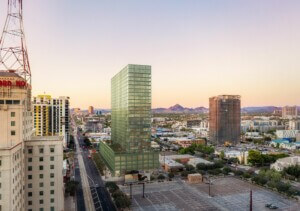The San Fernando Valley in Los Angeles has a reputation as a quintessentially suburban enclave. But, as the inner-city areas of Los Angeles have begun to embrace the hallmarks of traditional urbanism—increased housing density, fixed-transit infrastructure, and a dedication to pedestrian space—the valley has found itself parroting those same shifts in its own distinct way.
One area where this transformation is taking shape is housing, specifically, transitional and supportive housing for formerly homeless individuals.
According to the Los Angeles Homelessness Services Authority, the number of homeless people in the San Fernando Valley increased by 36 percent last year. Though the increase was significantly lower throughout L.A. County overall last year, one thing is clear: The number of people without homes in the areas around Los Angeles’s urban core area is growing. A similar trend is playing out across the country. Not only are urban homeless populations being increasingly displaced out toward the suburban areas by gentrification, but greater numbers of suburbanites themselves are becoming homeless, as well, due to a fraying social net and systematic income inequality.
Dire though the situation might be, Los Angeles—and the San Fernando Valley in particular—is currently poised to make strides in re-housing currently homeless individuals living in quasi-suburban environments by building a collection of new housing projects across the city. That’s because this November, 76 percent of L.A.’s voters supported Measure HHH, the city’s Homelessness Reduction and Prevention, Housing, and Facilities Bond. The initiative will raise $1.2 billion in bonds to pay for the construction of up to 10,000 units of housing for the homeless. The victory represents a shift in collective perspective that goes hand-in-hand with changing urban attitudes: As transit, density, and pedestrianism spread, so too has a visceral awareness that the city’s homeless population has been wholly abandoned by society and that action is overdue.
The passage of Measure HHH represents an opportunity for architects to assert themselves in civic and cultural discourse at an incredibly meaningful scale. And as much as the valley has begun to accept increased density, so too is it likely to see its fair share of new transitional and supportive housing as a result.
Already, the Skid Row Housing Trust (SRHT), a local affordable housing provider known for its focus on design quality, has begun to expand into neighborhoods beyond Skid Row. The organization opened a new set of apartments designed by Los Angeles–based architects Brooks + Scarpa this summer in the MacArthur Park neighborhood just west of Downtown Los Angeles. The project, called The Six, is the group’s first development with permanent supportive housing specifically for veterans. The name of the complex comes from the military shorthand, “got your six,” which means “I’ve got your back.”
The complex is designed around a central, planted courtyard and is expected to receive LEED Platinum certification from the U.S. Green Building Council. It features solar panels on the roof and ground-level supportive services for the residents, with a large public courtyard located on the second floor. Units rise up around the perimeter of the courtyard along a single-loaded corridor and are capped by a roof terrace and edible garden. The firm also calibrated the building’s architectural massing in order to respond to passive cooling and lighting strategies and features selectively glazed exposures as well as a courtyard layout that facilitates passive lighting and ventilation.
Another project under development by SRHT is Michael Maltzan Architecture’s (MMA) Crest Apartments in Van Nuys in the San Fernando Valley. Crest Apartments will deliver 64 affordable housing units for formerly homeless veterans. The building is laid out as a long, stepped housing block raised on a series of piers above multifunctional hard- and soft-landscaped areas. The long and narrow site shapes the complex such that the building’s mass steps around in plan as it climbs in height, creating vertical bands of windows aimed toward the street and side yard in the process. The ground floor of the complex contains supportive service areas as well as a clinic and community garden. The building recently finished construction and residents are beginning to move in.
The future of housing efforts in the valley is also being tackled by students at University of Southern California (USC), where a studio funded by the nonprofit Martin Architecture and Design Workshop (MADWORKSHOP) is aiming to develop a rapid-re-housing prototype to be deployed across the valley. The studio, formally unrelated to Measure HHH, is led by Sofia Borges, acting director at MADWORKSHOP and R. Scott Mitchell, assistant professor of practice at USC. The professors tasked architecture students with studying the spatial implications of homelessness at the individual person’s scale.
Ultimately, the studio, with nondenominational ministry Hope of the Valley as its client, developed the beginnings of a single-occupancy housing prototype that could be mass-produced and temporarily deployed to selected vacant sites in as little as two weeks. The cohort spent the semester meeting with officials in the city government, including the Los Angeles Department of Building and Safety, to work on an actionable plan for implementing their prototype. The students built a full-scale mock-up of the 96-square-foot unit for their final review and detailed plans for how the unit might be aggregated into larger configurations as a sort of first-response to help people transition from living on the streets to occupying more formal dwellings like The Six or Crest Apartments.










